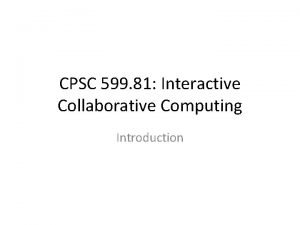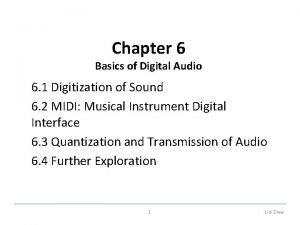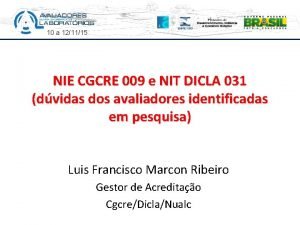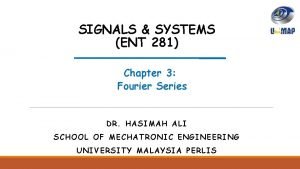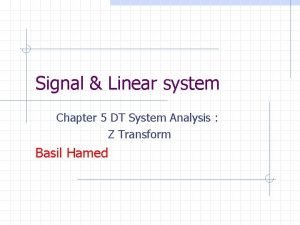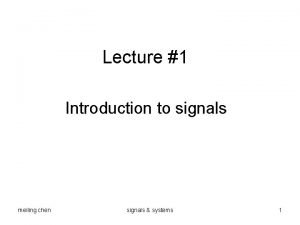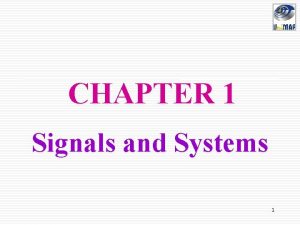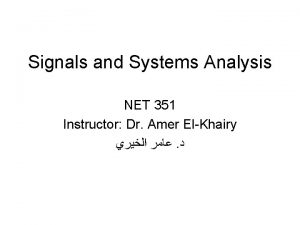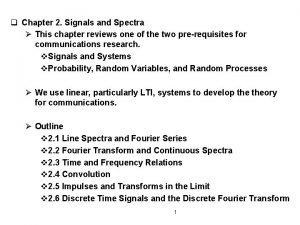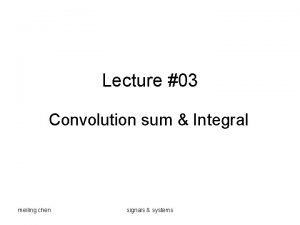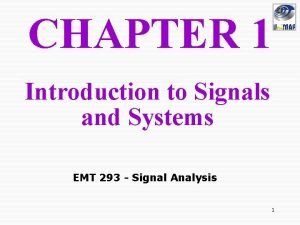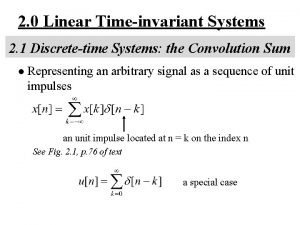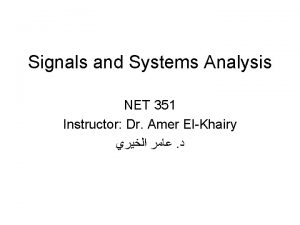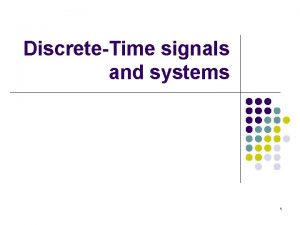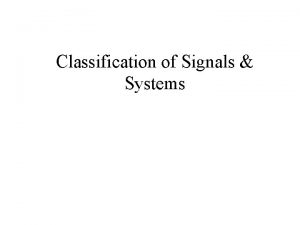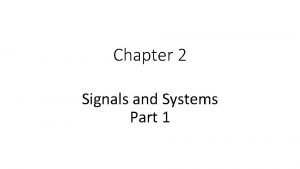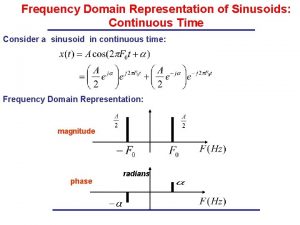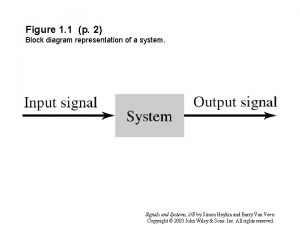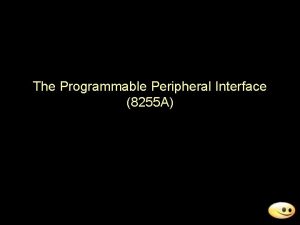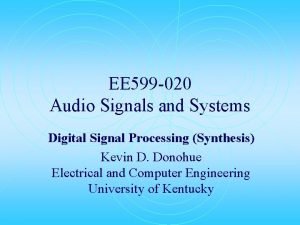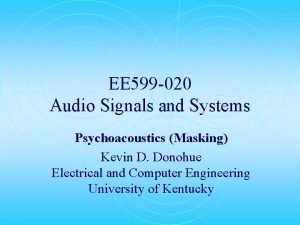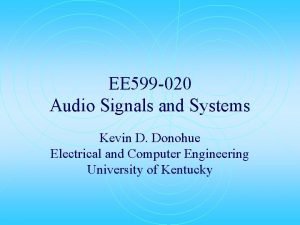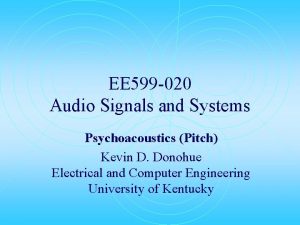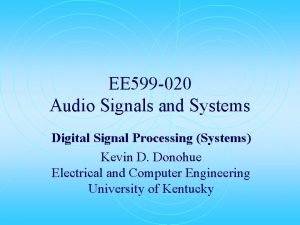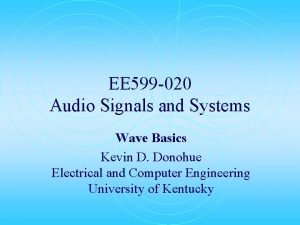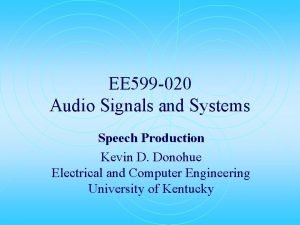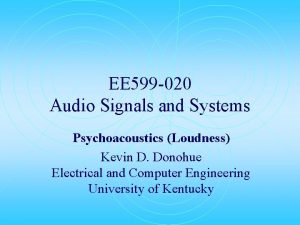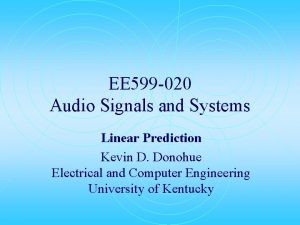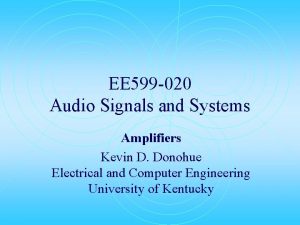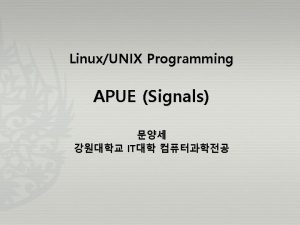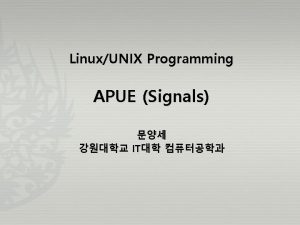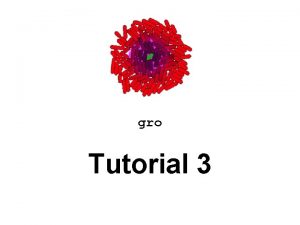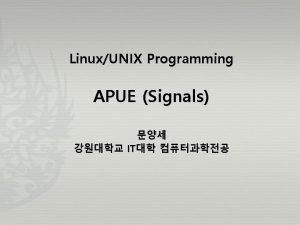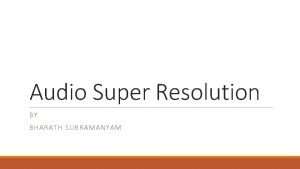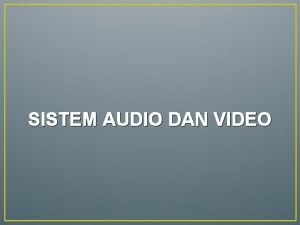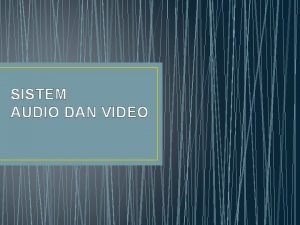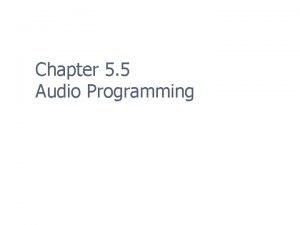EE 599 020 Audio Signals and Systems Effects



























- Slides: 27

EE 599 -020 Audio Signals and Systems Effects Kevin D. Donohue Electrical and Computer Engineering University of Kentucky

Related Web Sites Audio effects are popular among musicians and recording engineers. They typically involve linear and non-linear distortions to produce an artistic or aural impression. Related website are: http: //users. iafrica. com/k/ku/kurient/dsp/effects. html http: //www. dsv. su. se/~fk/DSP/dsp. html http: //www. harmony-central. com/Effects/

Amplitude/Envelope Effects Expanders and Compressors process the amplitude of the signal in a nonlinear (usually logarithmic) manner to modify dynamic ranges, suppress low-level noise, compand, and create effects.

Expanders/Noise Gates The input/output relationship of a zero-memory expander can be expressed with the following equation: where x(n) is the input, y(n) is the expanded output, xe is the threshold below which logarithmic scaling is applied, and is rate of attenuation (log slope) of the values below the expander threshold. The rate should range from 1 to infinity (10 is close enough).

Example Consider an speech file corrupted with low-level hiss (white noise). If the expander gate is set logarithmically to attenuate the signal by some factor (3: 1) for all signal under a value that is mostly greater than the noise amplitudes, then the hiss (especially in the areas of silenced will be suppressed).

Dynamic Expanders For the zero-memory expander the threshold is fixed, independent of signal amplitude. In most applications the attack and decay time of the threshold can set so the attenuation effectively delays its application when the signal falls below the threshold and its release when the signal goes above threshold. x(t) Level/Envelop Detector Gain Memory/Filter Attack/Decay Response y(t)

Example Consider an single tone whose amplitude jumps abruptly (below and above the expansion threshold. Apply LPF to the envelope used in threshold determination and describe effects on the output to various levels of LPF on the envelope. (threshold =. 2, ratio 10: 1, real pole on 1 st order LPF = 0 and. 995

Compressor/Limiting The input/output relationship of a zero-memory compressor can be expressed with the following equation: where x(n) is the input, y(n) is the expanded output, xe is the threshold below which logarithmic scaling is applied, and is rate of attenuation (log slope) of the values below the expander threshold. The rate should range from 1 to 0 (. 1 is close enough).

Example Consider an very loud and very soft sound being played simultaneously. Apply zero memory compression to reduce the dynamic range of the signal so both sounds can be hear more distinctly.

Dynamic Compressors For the zero-memory compressor the threshold is fixed, independent of signal amplitude. In most applications the attack and decay time of the threshold can set so the attenuation effectively delays its application when the signal falls below the threshold and its release when the signal goes above threshold. x(t) Level/Envelop Detector Gain Memory/Filter Attack/Decay Response y(t)

Noise Reduction The nonlinear processing presented in compression and expansion has been adapted for specialized noise reduction techniques. Especially if noise is due to quantization or dynamic range limitations of the recording/transmission media. See … • http: //hyperphysics. phy-astr. gsu. edu/hbase/audio/tape 4. html • http: //www. dolby. com/cassette/bcsnr/common. html • http: //www. epanorama. net/documents/telecom/ulaw_alaw. html

Quantization Error and Noise Analog Discrete Digital Ø Quantization has the same effects as adding noise to the signal: Ø Intervals between quantization levels are proportional to the resulting quantization noise. ØFor uniform quantization, the interval between signal levels is the maximum signal amplitude value divided by the number of quantization intervals. 11 10 01 00

Quantization Levels and Dynamic Range Ø An N bit word can represent 2 N levels Ø For audio signal an N bit word corresponds to: Nx 20 x. Log 10(2) d. B dynamic range Ø 16 bits achieve a dynamic range of about 96 d. B. For every bit added, about 6 db is added to the dynamic range. Ø The human ear can detect sounds from 1 x 10 -12 to 10 watts / meter 2 (130 d. B dynamic range)

Noise Reduction Ø If signals need to be recorded or transmitted on media that reduce dynamic range or adds noise, compression and expansion before storage and after playback can be use to enhance signal-to-noise and dynamic range. Ø Dolby. TM, dbx. TM, and mu-law companding noise reduction systems are examples of amplitude only encoders. Ø Signals can be compressed to fit the dynamic range of the media and expanded on playback. Ø If noise is added to the signal in a compressed state, expansion on playback will suppress the noise while restoring the signal. Ø If a compressed signal is quantized, the lower level amplitudes will effectively be quantized with a smaller interval than the larger amplitudes, thereby redistributing the quantization noise to louder signal amplitudes where it is less likely to be perceived.

Quantization Noise Ø Original CD clip quantized with 6 bits at original sampling frequency

Phase/Frequency Effects Several effects modify the signal phases to produce simulated reverb, delay, flanging, chorusing, and phasing.

Delay/Echo A simple FIR filter can be used to implement a single echo effect. x(n) Z-M b + y(n)

Delay/Echo with Regeneration An IIR filter can be used to implement regeneration with an echo effect. a x(n) + Z-M b + y(n)

Examples Determine the frequency response for the delay with and without regeneration. Describe how the delay effect will sound with and without regeneration. Describe how you could characterize a delay system? What test signals would be useful, what analysis would be used, what parameters could you determine?

Reverb A more complex series of regenerated echoes can be use to model a reverb effect Early reflections (Specular) FIR comb filters Late Reflections (diffuse) IIR all-pass filters

Flanging Combining a signal with a dynamic delay of itself creates a “whooshing” effects referred to as flanging. a x(n) + Z-M(n) b + y(n)

Time-varying system For M(n) following a sinusoidal pattern, flanging with no feedback can be expressed as: where M is the mean delay, d is the dynamic delay (sweep depth) expressed in samples, and fm is the modulation frequency of the dynamic delay. Typical flanging parameters for fm range from. 2 to 2 Hz and delays ranges from. 5 to 10 ms.

Examples Determine the frequency response for the flanger for fixed delay with and without feedback. Discuss what happens to the response when the delay varies. Describe how you could characterize a flanging system? What test signals would be useful, what analysis would be used, what parameters could you determine?

Chorusing creates the effect of multiple voices through multiple dynamic frequency shifts and time delays. This can be implemented with multiple flanging paths where bi is the scaling on each choruser Mi+di is the maximum delay expressed in samples, and fi is the modulation frequency of the sweep depth. Typical delay times for this effect are from 20 to 30 ms with dynamic delays on the order of 1 to 10 ms.

Frequency Response Modification Ø Most filtering effects give empahsis/deemphasis to a particular frequency region (equalization, shelving, parametric filtering, band-pass, stopband, high-pass, low-pass. . ) Ø Dynamic filters can also be used to create effects based on how the filter is varied while the sound is being played. This includes effects such as Wah and Vocoding.

Wah-Wah ØThe Wah-Wah effect is created by dynamic shifting the center frequency of a bandpass filter processing the audio signal. The user typically controls this with a pedal or sets the tempo for automatic variations. More complex features include different shaped filter, such as those based on the voice spectrum (sometime referred to as vocoding)

Charcterizing Wah-Wah • Describe how to determine the parameters of a Wah-Wah processor (test signals, processor settings, analyses …).
 Magni 575
Magni 575 The dewey decimal system was invented in
The dewey decimal system was invented in 210 dibulatkan ke puluhan terdekat menjadi
210 dibulatkan ke puluhan terdekat menjadi Cpsc 599
Cpsc 599 Communicative signals and informative signals
Communicative signals and informative signals Communicative and informative signals
Communicative and informative signals Communicative and informative signals
Communicative and informative signals Midi signals are digitized audio samples points
Midi signals are digitized audio samples points Ktkp-020
Ktkp-020 Miller plane generator
Miller plane generator For-cgcre-012
For-cgcre-012 Fourier series formulas
Fourier series formulas Signals and systems oppenheim solutions chapter 5
Signals and systems oppenheim solutions chapter 5 Precedence rule for time shifting and scaling
Precedence rule for time shifting and scaling Precedence rule in signals and systems
Precedence rule in signals and systems Convolution sum in signals and systems
Convolution sum in signals and systems Synthesis equation fourier series
Synthesis equation fourier series Convolution sum signals and systems
Convolution sum signals and systems Introduction to signals and systems
Introduction to signals and systems Convolution sum in signals and systems
Convolution sum in signals and systems Sinusoidal signal
Sinusoidal signal Signals and systems
Signals and systems Classification of signals and systems
Classification of signals and systems Signal and systems
Signal and systems Frequency-domain
Frequency-domain Signals and systems
Signals and systems Decision support systems and intelligent systems
Decision support systems and intelligent systems Which of the following are features of 8255a
Which of the following are features of 8255a



